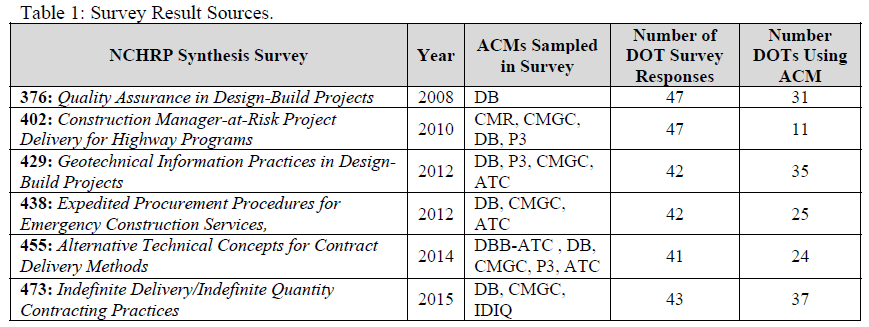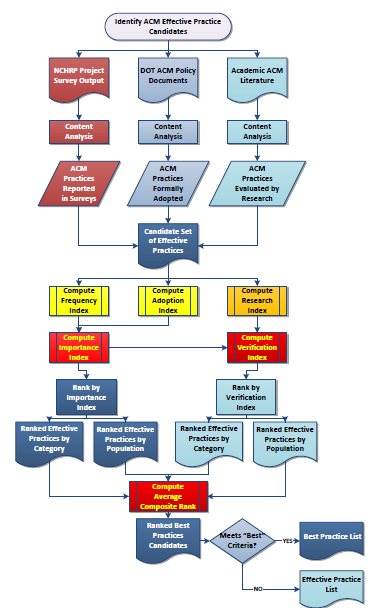ABSTRACT
Alternative Contracting Methods (ACM) usage has grown to the point where the industry has sufficient experience to provide a definitive set of best practices to both promote consistency in the nation’s procurement system and to leverage the lessons learned by early ACM adopters. The barrier to achieving this goal is that there is no uniform agreement on the definition of what constitutes a best practice.
This paper proposes both an objective definition and a framework for identifying and analyzing ACM practices that have been found to be effective by peer-reviewed research to determine if a given practice deserves to be termed as best practice. The framework is based on the series of indexes that are used to rank candidate practices in order of their importance and their effectiveness.
The 24 ACM practices evaluated were identified from 6 NCHRP Synthesis reports on ACM topics. The paper finds that only 4 of the 24 candidates meet the objective criteria to be termed a best practice. These were 1) Formalizing and institutionalizing agency ACM procedures, 2) Use of 2-step best-value award procedures, 3) Appointing an agency ACM champion, and 4) Offering stipends for unsuccessful competitors.
BACKGROUND
In the past 30 years, the highway construction industry has been tinkering with the traditional design-bid build (DBB) low bid award process in a quest for a more efficient, less adversarial approach to delivering transportation projects. The Utah Department of Transportation’s (DOT) used design-build (DB) contracting as a means to complete the upgrade for I-15 in time for the 2002 Winter Olympics, which served as the initial impetus for other state DOTs to experiment with DB and with other ACMs. In 2010, the Federal Highway Administration (FHWA) initiated its Every Day Counts (EDC) program. The initiative was aimed at increasing the use of previously proven ACMs to accelerate the delivery of infrastructure renewal projects.
SEMANTICS
It is important to note that ACM definitions are not standardized from state to state and are often a function of each DOT’s enabling legislation. It is literally impossible to cover all possible definitions in a paper of this length, instead the reader is referred to the prior cited website (ref) for detailed definitions of each ACM.
For example, FHWA prefers to use the term CMGC to differentiate heavy civil projects with a minimum percentage of contractor self-performance from Construction Manager-at-Risk (CMAR) which is common in the commercial building industry where the CMAR often subcontracts all the construction work (6). However, the Arizona, Florida, and Maryland DOTs, to name three, use CMAR for highway projects, and the legislation in Washington State calls the ACM GC/CM and caps contractor self-performance at a maximum 50%.
METHODOLOGY
The methodology was developed to provide a rigorous means to differentiate between commonly observed ACM practices and effective practices per the above definition. The primary research instrument was textual content analysis of material found in the academic literature and a separate content analysis of material found in state DOT ACM documents like DB manuals, etc. “Researchers regard content analysis as a flexible method for analyzing text data”.
RESULTS OF THE ANALYSIS

LIMITATIONS, CONCLUSIONS AND RECOMMENDATIONS
This paper’s primary contribution is to propose a framework for classifying ACM best practices based on objective criteria of recorded superior results and benchmark suitability. The framework uses content analysis of three independent sources of information, which is then compared using a series of indexes that are adapted from II theory proposed by Assaf and Al-Hejji. Best practices are selected from a population of ACM effective practices that are “research-based practices identified through high quality quantitative study, but not yet meeting the strict criteria needed to become a benchmark”.
The conclusions outlined below have one limitation and it relates to the source of the initial population of candidate effective practices. All came from research conducted by the NCHRP synthesis program and as such are specifically related to ACMs as practiced by US state DOTs and may not be applicable to other parts of the world or other industries. It must be noted that the synthesis results are peer-reviewed by a panel of 8 practitioners before being accepted for publication, providing a high level of confidence that practices identified as effective in a synthesis are indeed so.
The study resulted in several conclusions with respect to the issue of identifying best practices in ACMs. First, a uniform definition that differentiates a best practice from all other effective practices was developed. In essence, if a given practice does not meet the criteria to be used as a benchmark, it must be considered merely as effective. Secondly, the framework for objectively differentiating between effective and best practices was found to be useful and the methodology presented can be generalized to the same type of analysis of ACM practices in other industries and markets. It can also be generalized to other areas of NCHRP research where the terms effective practices and best practices can be used. The use of Importance Index theory proved to be very flexible and was easily adjusted to suit the needs of this particular analysis.
Source: Iowa State University
Authors: Douglas D. Gransberg | Eric Scheepbouwer | Carla Lopez del Puerto
